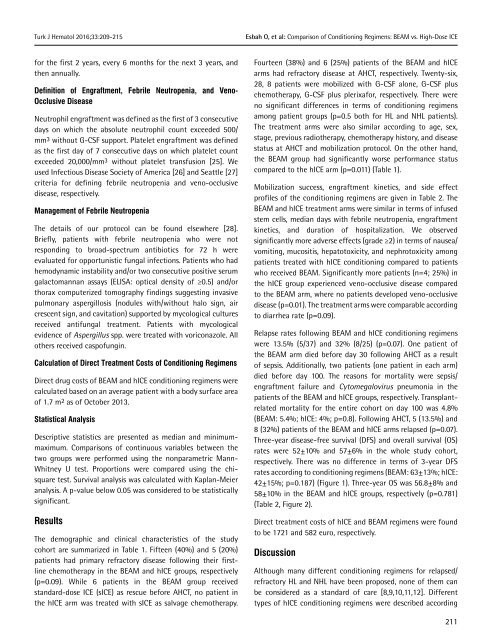Turkish Journal of Hematology Volume: 33 - Issue: 3
Create successful ePaper yourself
Turn your PDF publications into a flip-book with our unique Google optimized e-Paper software.
Turk J Hematol 2016;<strong>33</strong>:209-215<br />
Esbah O, et al: Comparison <strong>of</strong> Conditioning Regimens: BEAM vs. High-Dose ICE<br />
for the first 2 years, every 6 months for the next 3 years, and<br />
then annually.<br />
Definition <strong>of</strong> Engraftment, Febrile Neutropenia, and Veno-<br />
Occlusive Disease<br />
Neutrophil engraftment was defined as the first <strong>of</strong> 3 consecutive<br />
days on which the absolute neutrophil count exceeded 500/<br />
mm3 without G-CSF support. Platelet engraftment was defined<br />
as the first day <strong>of</strong> 7 consecutive days on which platelet count<br />
exceeded 20,000/mm3 without platelet transfusion [25]. We<br />
used Infectious Disease Society <strong>of</strong> America [26] and Seattle [27]<br />
criteria for defining febrile neutropenia and veno-occlusive<br />
disease, respectively.<br />
Management <strong>of</strong> Febrile Neutropenia<br />
The details <strong>of</strong> our protocol can be found elsewhere [28].<br />
Briefly, patients with febrile neutropenia who were not<br />
responding to broad-spectrum antibiotics for 72 h were<br />
evaluated for opportunistic fungal infections. Patients who had<br />
hemodynamic instability and/or two consecutive positive serum<br />
galactomannan assays (ELISA: optical density <strong>of</strong> ≥0.5) and/or<br />
thorax computerized tomography findings suggesting invasive<br />
pulmonary aspergillosis (nodules with/without halo sign, air<br />
crescent sign, and cavitation) supported by mycological cultures<br />
received antifungal treatment. Patients with mycological<br />
evidence <strong>of</strong> Aspergillus spp. were treated with voriconazole. All<br />
others received casp<strong>of</strong>ungin.<br />
Calculation <strong>of</strong> Direct Treatment Costs <strong>of</strong> Conditioning Regimens<br />
Direct drug costs <strong>of</strong> BEAM and hICE conditioning regimens were<br />
calculated based on an average patient with a body surface area<br />
<strong>of</strong> 1.7 m2 as <strong>of</strong> October 2013.<br />
Statistical Analysis<br />
Descriptive statistics are presented as median and minimummaximum.<br />
Comparisons <strong>of</strong> continuous variables between the<br />
two groups were performed using the nonparametric Mann-<br />
Whitney U test. Proportions were compared using the chisquare<br />
test. Survival analysis was calculated with Kaplan-Meier<br />
analysis. A p-value below 0.05 was considered to be statistically<br />
significant.<br />
Results<br />
The demographic and clinical characteristics <strong>of</strong> the study<br />
cohort are summarized in Table 1. Fifteen (40%) and 5 (20%)<br />
patients had primary refractory disease following their firstline<br />
chemotherapy in the BEAM and hICE groups, respectively<br />
(p=0.09). While 6 patients in the BEAM group received<br />
standard-dose ICE (sICE) as rescue before AHCT, no patient in<br />
the hICE arm was treated with sICE as salvage chemotherapy.<br />
Fourteen (38%) and 6 (25%) patients <strong>of</strong> the BEAM and hICE<br />
arms had refractory disease at AHCT, respectively. Twenty-six,<br />
28, 8 patients were mobilized with G-CSF alone, G-CSF plus<br />
chemotherapy, G-CSF plus plerixafor, respectively. There were<br />
no significant differences in terms <strong>of</strong> conditioning regimens<br />
among patient groups (p=0.5 both for HL and NHL patients).<br />
The treatment arms were also similar according to age, sex,<br />
stage, previous radiotherapy, chemotherapy history, and disease<br />
status at AHCT and mobilization protocol. On the other hand,<br />
the BEAM group had significantly worse performance status<br />
compared to the hICE arm (p=0.011) (Table 1).<br />
Mobilization success, engraftment kinetics, and side effect<br />
pr<strong>of</strong>iles <strong>of</strong> the conditioning regimens are given in Table 2. The<br />
BEAM and hICE treatment arms were similar in terms <strong>of</strong> infused<br />
stem cells, median days with febrile neutropenia, engraftment<br />
kinetics, and duration <strong>of</strong> hospitalization. We observed<br />
significantly more adverse effects (grade ≥2) in terms <strong>of</strong> nausea/<br />
vomiting, mucositis, hepatotoxicity, and nephrotoxicity among<br />
patients treated with hICE conditioning compared to patients<br />
who received BEAM. Significantly more patients (n=4; 25%) in<br />
the hICE group experienced veno-occlusive disease compared<br />
to the BEAM arm, where no patients developed veno-occlusive<br />
disease (p=0.01). The treatment arms were comparable according<br />
to diarrhea rate (p=0.09).<br />
Relapse rates following BEAM and hICE conditioning regimens<br />
were 13.5% (5/37) and 32% (8/25) (p=0.07). One patient <strong>of</strong><br />
the BEAM arm died before day 30 following AHCT as a result<br />
<strong>of</strong> sepsis. Additionally, two patients (one patient in each arm)<br />
died before day 100. The reasons for mortality were sepsis/<br />
engraftment failure and Cytomegalovirus pneumonia in the<br />
patients <strong>of</strong> the BEAM and hICE groups, respectively. Transplantrelated<br />
mortality for the entire cohort on day 100 was 4.8%<br />
(BEAM: 5.4%; hICE: 4%; p=0.8). Following AHCT, 5 (13.5%) and<br />
8 (32%) patients <strong>of</strong> the BEAM and hICE arms relapsed (p=0.07).<br />
Three-year disease-free survival (DFS) and overall survival (OS)<br />
rates were 52±10% and 57±6% in the whole study cohort,<br />
respectively. There was no difference in terms <strong>of</strong> 3-year DFS<br />
rates according to conditioning regimens (BEAM: 63±13%; hICE:<br />
42±15%; p=0.187) (Figure 1). Three-year OS was 56.8±8% and<br />
58±10% in the BEAM and hICE groups, respectively (p=0.781)<br />
(Table 2, Figure 2).<br />
Direct treatment costs <strong>of</strong> hICE and BEAM regimens were found<br />
to be 1721 and 582 euro, respectively.<br />
Discussion<br />
Although many different conditioning regimens for relapsed/<br />
refractory HL and NHL have been proposed, none <strong>of</strong> them can<br />
be considered as a standard <strong>of</strong> care [8,9,10,11,12]. Different<br />
types <strong>of</strong> hICE conditioning regimens were described according<br />
211

















